Vicony Tea Directory


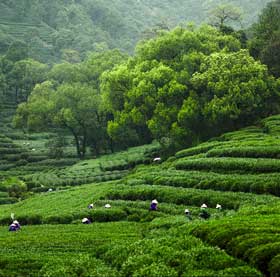 |
|
| Mei Jia Wu- one of the original longjing tea producing areas |
Longjing Tea(龙井茶)
What is Longjing Tea
The name of Longjing Tea (literally translated as Dragon Well) may come from four sources,tea tree,the well,the temple and the spring. This tea comes from the shores of West Lake (Xi-hu),at Hangzhou City,Zhejiang Province,China.
Long time ago,Longjing Tea was highly praised for its absolute beauty in four aspects: greenish color,elegant fragrance,mellow taste and prettiness in appearance. The delicate fragrance is very long-lasting and bright liquor gives a refreshing, brisk, mellow and sweet aftertaste.
To process Longjing Tea,the tea leaf must undergo intensive pan-frying steps by hands during the entire process. In a custom-made pan,the leaves are repeatedly stirred and agitated by hand with different hand gesture: as many as 10 different styles (十大手法 Shi-da Shou-fa) are a must.

There are many versions of longjing tea found in the market,nevertheless,the best longjing tea comes from its original place,the Longjing Village (Long jing cun) which covers several historically renowned longjing tea producing areas. At present, there are many tea produced from other places in Zhejiang Province,which is called Zhejiang longjing tea. However,due to the unique climatic environment and different manufacturing expertise, the quality is different from that of origin. Besides,the producing areas at certain places of Zhejiang Province are located in urban area which is exposed to the risk of heavy metal contamination from vehicles and industrial area.
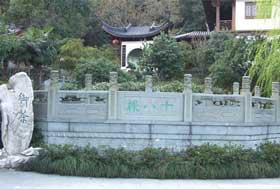 |
|
| The 18 longjing tea trees(十八棵)which were granted as Imperial Tea Trees (御茶)by Emperor Qiang-Long |
History & Culture of Longjing Tea
Longjing tea is one of Chinese historical tea. The making of longjing tea was dated back to 1,500 years ago. It is said that longjing tea was recorded as early as Song Dynasty in the world first tea book,Cha-Jing (The Tea Scripture written by Lu Yu). Once upon a time, it was named after the names of mountains: (Xiang-lin-cha), (Bai-yun-cha) and (Bao-yun-cha). Longjing tea was blooming during Yuan (元) and Ming (明) Dynasties. It was named as longjing tea since Song Dynasty. The name of longjing tea was well-known during late Qing Dynasty.
It is said that during the Qing Dynasty,Emperor Qiang-Long visited the Shi-feng Mountain and was served with longjing tea. He was very impressed with its beautiful appearance,elegant fragrance and mellow taste. The monk who served the tea introduced the tea and brought him to the tea garden,at that time, there were 18 tea trees. While he was enjoying plucking the tea leaves,urgent news arrived saying his mother had fallen ill and urged him to return to the palace. During his visit to his sick mother,the scent of tea leaves that he kept in his pocket emitted and attracted his mother’s attention. Without second a thought, he served the tea to his mother and she enjoyed its pleasant taste and flavor very much. After drinking for several times,she was fully recovered. The Emperor was very grateful to the tea and granted the 18 tea trees as the Imperial Tea Tree. Since then, Longjing tea became one of tribute tea to emperors. Up to date,the 18 tea trees remain at the Shi-feng Mountain.
Until now,Longjing held its first place among the Top Ten Chinese Tea. It has been the National Tea ( Guo-cha), and was always selected as a gift for foreign guests. Year after year,its fame as the Queen of Green Tea established.
Growing Area of Longjing Tea
The original longjing tea came from the producing area at Longjing Village,which is situated at the shore of West Lake (Xihu).During the history,longjing tea was divided into five categories according to five main producing areas: Shi-feng Mountain,Mei-jia-Wu area,Weng-jia-shan Mountain,Yun-xi area,and Hu-pao area.
Today,Longjing is usually categorized into 4 different groups: 狮 (Shi), 梅 (Mei), 西湖 (Xihu, means West Lake), and longjing from other places of Zhejiang Province called Zhejiang Longjing.
The tea growing area is surrounded with fog throughout the year. One of the essential factors for good Longjing tea is the mellow taste. This taste originates from the amino acid called theanine. Young buds contain high level of theanine but it is converted to polyphenol such as catechins when tea leaves receive sun light. On the other hand,less sunshine will preserve high levels of theanine in leaves as bio-conversion is not effectively taking place. The area is often covered by fog which blocks the direct sunlight on tea leaves.
Besides,the soil has strong water holding capacity and good penetrating character which is important to retain sufficient moisture in the soil. In addition,the soil is quartz sandstone which provide an acidic pH,which is suitable for growing tea tree.
Tea Cultivar and Plucking season of Longjing Tea
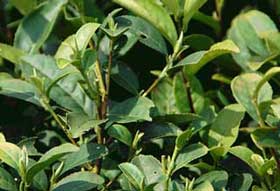 |
|
| Cultivar Longjing N0.43 |
The best tea cultivar for longjing tea is cultivar No.43. The longjing tea produced of leaves from this cultivar gives distinguishing character: the dried tea leaves are flat,straight and sleek with sharp-tips and delicate green bud with yellowish edge. When brewed,it gives a long-lasting delicate fragrance with mellow taste. Besides,the sprouting occurs simultaneously and uniformly,producing bud and leaf even in color and size. This is key to making high grade tea with remarkable neat appearance. Furthermore,every year,Cultivar No. 43 is earlier than other cultivars to begin sprouting for 7-10 days. In China,the earlier the longjing tea on the market,the better the selling price. Drinking the earliest tea during spring is the culture which people are fond of. Therefore,this cultivar is highly appreciated by farmers. The longjing tea cultivar No.43 passes the assessment by chinese tea experts and is recognized as a fine breed.
During the early spring,one bud and one leaf or one bud with two leaves (which just starts to open up) is hand-plucked. The length of bud is 2.5 – 3.0 cm. The length of bud is an indication reflecting the degree of delicacy of tea leaves.
The plucking is carried out as early as possible to harvest young shoots. It is said that the best time to harvest longjing tea is before Qing Ming (清明),occurring on April 4 (leap years) or April 5 (other years) of the Gregorian calendar),the product is named as 明前茶 (Ming-qian Cha). Subsequently,tea harvested before Grain Rain (谷雨)named as 雨前茶 (Yu-qian Cha) is second in quality.
During a day,even an old hand can only manage to harvest as much as 1.0 - 1.5kg of young shoots. In any event,0.5kg contains about 60,000 pieces of young shoots.
In addition,the tea leaves must be carefully selected during plucking:
1) Pick the bud and leaf of the same size, in even and orderly form
2) Do not pluck together with the long stalk
3) Do not pluck bud/leaf in purple color
4) Do not pluck bud and leaf which is damaged by plant disease
5) Do not pluck the tiny leaf attached to bud.
After plucking, the leaves are transferred to a indoor cool place. During the sunny days,the tea leaves are spread to a thin layer (3 – 5 cm) and left for 6 – 12 hours without turning or mixing; but if the leaves are plucked after rain or contains much dew,the tea leaves are spread to a much thinner layer then lightly turned and mixed for 2 – 3 times. It must be carried out with much care and attention so as not to cause damage to the leaves (damaged leaves will turn red,affecting the quality of end product). During this period,the water content is vaporized from fresh leaves until it is reduced to about 70%. The spreading makes the leaves to emit a greenish grassy smell,resulting in reduction of bitterness and astringency, By increasing amino acid concentration it improves the briskness of liquor. In addition,it helps to prevent leaves becoming lump during frying.
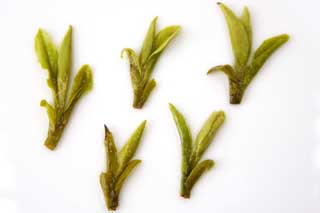 |
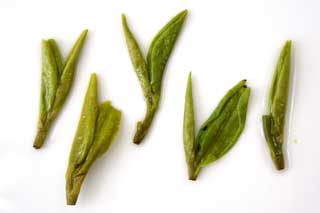 |
||
| Brewed leaves of Longjing Tea made of Cultivar Longjing No. 43 | Brewed leaves of Longjing Tea made of other cultivar |
Production Process of Longjing Tea
Withering
Tea leaf after plucking is moved into well ventilated room where it is spread in a layer of 3-5cm for 6-12 hours to reduce moisture to 70%. It is a process aimed at reducing greenish aroma & bitterness and increasing relative percentage of amino acid.
Pan Frying - Inactivation of Enzyme
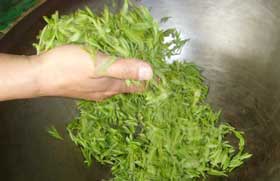 |
|
| Pan Frying Process of Longjing Tea |
During the first pan frying,the purpose of 殺青 is to inactivateoxidative enzyme such as polyphenol oxidase (PPO) with heat,as well as forming the preliminary shape of longjing. With high temperature,it takes a very short time to heat the tea leaves and inactivate oxidative enzyme. When the temperature reaches 80-100˚C,place about 100 g of tea leaves into the pan and fry by hand. At the start,the main hand-gesture is to grasp the leaves up to about 10 cm in height away from the pan and slowly sprinkle the leaves to vaporize the moisture from the leaves. After frying for 3 – 4 minutes,the leaf turns soft. By then,the hand-gesture is changed to put-over,press or holds down,shivering and fling or throws off. Progressively increase the pressure by hand. This step is critical to forming the preliminary shape of longjing. The leaves are straightened into narrow-shaped strips and flattened. The skillful tea master has to carefully manage the timing of action and pressure induced by hand: too much pressure,incorrect hand motion and if pressed too soon,tea leaves become dark in color; on the other hand,non-straightened and non-flattened tea leaves indicate that the hand pressure applied is insufficient and/or the pressing carried out is too late.
After frying for 12 – 15 minutes when the moisture content of leaves is reduced to 20-30%,remove the leaves from pan.
Cooling
The fried leaves are spread out to 15 – 20 cm and cooled down for about 40 - 60 minutes. At this time,tea leaf re-absorbs moisture and softens (called 回潮Hui-chao).
After cooling,the softened leaves are winnowed to remove broken and light pieces of leaves and then hand-sorted to get rid of dull,burnt,yellow pieces,red colored leaves,stalk and any foreign materials. Subsequently,the sorted leaves are sifted to obtain the first batch of leaves that is retained on the top sifter,while the leaves that pass the sifter is collected and sifted again to obtain the second batch which is retained on sifter and third batch, i.e. leaves pass the sifter. These three different batches of leaves will proceed for second frying separately.
Second Pan Frying - Forming the shape and drying
The purpose of second pan-frying is to form the shape and further remove moisture. Usually,about 4-5 batches of tea leaves from 1st heating are gathered together and proceed for second heating. The collected leaves are about 250g in total. The initial temperature of pan is about 60 – 80˚C,fry leaves until they are heated up and softened and down reveal (露茸毛 Lu-rong-mao),then increase the temperature to 80 – 90˚C and continue frying. When down drops and leaves are tightened up to flat and smooth strips,the temperature is reduced to 50˚C.
During frying,the pressure induced by hand is gradually increased. It involves the hand action of put-over, buckling,rubbing,press and push. The gist is that the leaves must always be in contact with the hands and the tea leaves should not be away from the pan. Toasting is continued until the down drops from the leaves and leaves become flat,smooth and sleek. When the leaves emit their own fragrance and could easily fracture with moisture content reduced to 5 – 6%,the frying is sufficient. It takes 25 minutes in total.
Quality Inspection Criteria For Longjing Tea
Dried Longjing Tea Leaves
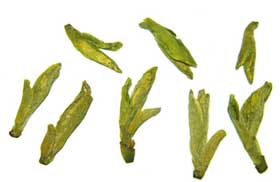 |
|
| Dried Longjing Tea Leaves |
Leaf is flat,lustrous and straight with sharp pointed tips.The leaf length is from 2.5 to 3.0 cm covered with a white down that is not easily seen and will unfurl when brewed. If of poor quality,the length is longer,shape is less flat and blunt. When looking at the leaves,if too much ‘fish eye bubble’ (鱼眼泡 Yu-yan Pao) is found on the surface,the leaf is over-fried. Even though the shape of leaf is as described above,it is not of good quality as the taste would be bitter.
Color of dried leaves: Yellowish green color,even,bright and lustrous. For poor quality,the leaf is not lustrous, in darker green color with a dull appearance and mixed with leaves of various colors. Besides,over-fried leaf appears to be in dark grayish color.
Regularity
The good quality tea consists of pieces of leaf of fairly even size and color. Poor quality tea contains a lot of broken pieces and mixed with broad strips of leaves. The leaf is a mixture of yellowish or dark green.
Cleanliness
The well-made tea must be free from extraneous matter such as fiber,bamboo or wooden flakes,sand or stone, dust.
Aroma
The dry leaf gives fresh and greenish note,while the aroma of poor quality tea is overcast and can hardly being sensed. When brewed,the liquor gives a fresh green note and long-lasting flavor. This is the characteristic of the most superior longjing which is highly sought after,indicating the high quality of raw material being produced with the proper handling process. It is also recognized as it has an aroma of chestnut. The poor quality product gives a grassy flavor which is similar to stewed vegetable or green pea. If the leaf is over-fired,the strong firing note or even burnt aroma is detectable.
Color of Liquor
Bright, clean and pure,with delicate bluish green color. For poor quality tea,the liquor is yellowish or dull yellowish color.
Taste
The taste is brisk,refreshing,smooth,and mellow and has a sweet aftertaste. If the tea is of poor quality,the taste is astringent and bitter with greenish grassy taste.
Brewed Longjing Tea Leaves
The brewed leaves show a fresh,bright and even green color. The leaves are well-attached to the bud,like the flower petals. When touched with the finger,the leaves are thick but soft and elastic. For poor quality tea,the brewed leaf consists of much broken pieces in dark green color or yellowish brown color. It is mixed with separate leaves without a bud. The red spot found on the leaves indicates poor-handling – the leaves are damaged during plucking or spreading which cause oxidation of enzyme to take place before blanching. Besides,good quality tea should not contain much insect bitten leaves which show uneven holes on the leaves. In addition,if the leaf is over-fried at higher temperature and burnt,the holes with even shape can be seen on the brewed leaf. The real longjing cultivar comes with the bud closely attached with leaf/leaves to form the small and exquisite shape like flower. The bud is slightly longer than the leaf which is narrower in width(about 0.5-1cm), while other cultivars contain leaf which is wider,bigger and longer than the bud and not so closely attached to the bud. When compared to the leaves of other cultivars,those of real longjing cultivar are smoother and sleeker.The brewed leaves retain a mild fresh note while those of other cultivars give a greenish grassy note or sometimes give no smell at all after brewing.
How to Brew Longjing Tea
| Green Tea | Black Tea | White Tea | Yellow Tea | Oolong Tea | Dark Tea | Pu Erh | Scented | Flowering | Herbal | Tea Powder |
| Navigation |
| Home (ViconyTeas) |
| Tea Directory (VTD) |
| Tea Importers |
| Tea Exporters |
| Tea Wholesalers |
| Informative Tea Web |
| Tea Association |
| Tea Encyclopedia |
| Online Tea Shop |
| Tea Dictionary Online |
Copyright©2016 | Longjing Tea
